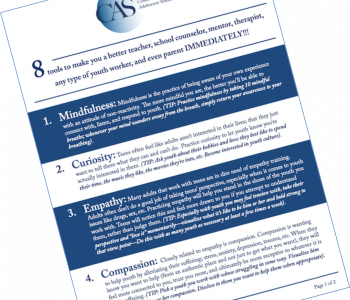

Sam Himelstein, PhD
Sam Himelstein, PhD is the founder of both the Center for Adolescent Studies, and Family Spring, Inc.
3 Ways Compassion Can Help Youth Impacted by Trauma
One day in a Roots of Empathy program, a young mother brought her six-month-old baby to the class and asked if anyone wanted to hold him. The first kid to volunteer was Darren, a tough-looking fifteen-year-old who had a shaved head covered with a large tattoo. Darren had been in foster care for more than ten years, after his own mother was killed in front of him.
After the baby’s mother nervously handed him her infant,
“Darren put him in the harness, turned toward his chest, and the baby snuggled there peacefully. He carried him over to a quiet corner of the room and rocked him back and forth for several minutes. Eventually he returned to where the mother and instructor were waiting and asked, ‘If no one has ever loved you, do you think you can be a good father?’[…]Thanks to those few moments of contact with a baby’s unconditional affection, a teenager whose life had been marked by tragedy and neglect began to build a different image of himself and the relationships possible between humans.” (from Matthieu Ricard, Altruism: The Power of Compassion to Change Yourself and the World)
This story doesn’t surprise me. As a therapist who works with youth in the juvenile justice system, I get asked all the time: “How do you teach mindfulness to gang members, to people with tattoos on their face?” The truth is, every teenager in juvenile detention isn’t a hardened aggressive person. If you look beneath the surface, you’ll see individuals with different personalities and concerns. They likely have experienced multiple traumas, and they may be living in an environment where they have to act tough in order to survive.
The key to working with youth, particularly youth in the juvenile justice system or in communities impacted by violence, is to interpret their resistance and what many adults would call “acting out” or being “oppositional” from a trauma-informed lens. Knowing something about the trauma they’ve experienced helps me cultivate compassion for my clients, even on days when they’re challenging to work with.
Here are three ways you can integrate compassion practices into your work with youth.
1) Do a brief lovingkindness meditation before each session with a challenging individual or group.
They could be challenging to work with because of the level of trauma they’ve experienced. Or a particular individual or group could push your buttons in some way. Before each session, try to find a comfortable space where you can sit uninterrupted for about 5-7 minutes, and do a compassion meditation focused on your clients, patients, or students.
This is what I do personally; if it doesn’t resonate with you, you could alter the phrasing or substitute a prayer from your faith tradition:
1) I take a few deep breaths in and a few deep breaths out. I notice the sensations of the breath in my belly, chest, and nostrils.
2) I bring forth an image of the individual or group of youth who are causing me stress.
I notice any feelings or thoughts that arise and just breathe with them. I don’t judge or try to avoid my feelings, just let myself experience the anger or frustration or sadness.
3) I visualize this teen as an innocent child or infant who hasn’t been hardened yet.
4) I contemplate the trauma this client or group of youth have faced in their young lives.
5) I acknowledge that their challenging attitude or behavior is likely a protective mechanism resulting from the trauma they’ve experienced.
6) I think of a strength or resilience factor or other positive quality of this individual or group of youth.
7) I silently repeat the following phrases, imagining that I’m sending vibrations of compassion toward the youth.
- May you be happy and peaceful.
- May you be healthy and safe.
- May you heal from the traumas you’ve endured.
- May your strengths shine through your armor.
- May you be free from suffering.
When I first started doing this type of compassion meditation, it felt like I was just reciting empty phrases. Over time, however, it became more and more authentic. Now I feel deeply connected to the practice, which helps me feel deeply connected to the youth in my care. In turn, this helps me engage with them in a productive way, hoping to help ease their suffering
2) TAP into compassion at challenging moments during the session.
TAP stands for Take a breath, Acknowledge, and Proceed.
First,“take a breath,” pausing and becoming present. It’s the first step in skillfully responding to any tense situation, especially when working with trauma-impacted youth.
Next “acknowledge” your own feelings and experience, as well as the likely feelings and experience of the youth. For example, in considering your own reactions, you might feel overwhelmed hearing about extreme trauma. Or perhaps you feel frustrated that the youth doesn’t seem to be listening to you or is reacting with hostility to your attempts to help. In considering what’s going on for the youth, you might remind yourself that their resistance is likely a protective mechanism.
We don’t always realize how challenging it can be to engage in therapy or other interventions. As one former gang member puts it,
“I’ve been shot at close range; been stabbed a couple a’ times; been on life support, jumped, and beaten. If someone wants to come at me… I’m not even a little bit scared. Bring it on… But put me in a room alone with a counselor and ask me about what happened to me as a child? That scares the fuck out of me. Then I’m just a little boy in a big-ass room.” (Father Gregory Boyle, Barking to the Choir: The Power of Radical Kinship, p. 158)
After you’ve acknowledged your challenges and the challenges of your clients, “proceed” to take action in whatever way is most appropriate. You might express your compassion verbally, or show through eye contact and body language that you’re paying attention to them and are concerned about them. Or, if someone has crossed a line or some group members are in conflict with each other, you may need to set or reinforce a boundary in a way that treats everyone with dignity.
With practice, your TAP might only last a few seconds, just enough of a pause to be able to respond skillfully to the situation.
3) If appropriate, teach compassion meditation to your patients, students, or clients.
After you’ve become comfortable with your own practice of compassion, you might want to teach TAP or compassion meditation to your patients, students, or clients. You can let them know that you find a particular type of meditation helpful and are willing to share it with them.
Don’t push them if they aren’t interested in meditation, but don’t assume they won’t be interested. You never know who might be open to meditation and what kind of impact it might have in their lives.
After teaching a simple breath-based meditation to a group at juvenile hall, one of the kids told me:
“You know what, man? That meditation, it really helped me out. I’ve been meditating for about fifteen minutes every day in my room since we last met.”
Another time, one of my colleagues was leading a compassion meditation: “May I be happy, may I be healthy, may I be safe.” With only a couple of seconds before he was going to ring the bell, one particular youth (let’s call him “Charlie”) suddenly opened his eyes and popped out of the meditation. It seemed like he had a shock to his system.
After the instructor rang the bell, he turned to Charlie and said,
“I noticed that you popped out of that meditation pretty quick. I was just wondering if you were okay and what was going on with you and what was that experience like?”
Charlie said,
“I just had a vision, and I could see myself when I was meditating. And when I said, ‘May I be happy” I literally saw myself as a 2-year-old playing with blocks on the floor. And then when I said, ‘May I be healthy’ I could see myself back in my neighborhood, on my block, with my joint in my hand, and right when I said, ‘May I be healthy,’ I noticed myself flicking the joint away, and walking away from it. And when I said, ‘May I be safe,’ I noticed myself on my block, in my neighborhood again, and I noticed that I had my gun in my pants. And immediately when I said, ‘May I be safe,’ I took the gun out and I threw it away in the garbage and walked away.”
This was amazing to hear, since Charlie was a high-ranking gang member at just sixteen years old. He was about to be transferred to an adult penitentiary, where he would be incarcerated for about 10 years after being charged with a serious crime.
People have sometimes asked me, ‘What’s the point with a kid like that?’ Here’s the point: That kid will be released from prison when he’s twenty-six years old. He still has a life ahead of him. By having that experience with compassion meditation, he planted a seed within himself that may grow in various ways when he’s in the penitentiary and grow in various ways when he gets out. He needs to view the world in a certain way in order to survive prison, but that experience of compassion will still be a seed growing inside him, and he’ll have the opportunity to reflect on it and water that seed.
Conclusion
“A former gang member, who was abandoned as a child, incredulously asked his therapist after she’d expressed concern for him—
‘You mean, you think of me, when you’re not here?’
She nodded.
‘Wow. I never pictured that anyone would think of me when they’re not here.” (Fr. Gregory Boyle, Barking to the Choir, p. 16-17)
Treating youth with compassion doesn’t mean letting them off the hook for inappropriate or aggressive behavior. It means recognizing their humanity and suffering, and treating them like human beings with the potential for positive change.
Whether or not you decide to teach lovingkindness meditation to the youth in your care, engaging in a personal compassion practice can help sustain you on those days when their behavior or reactions are challenging to deal with.
Also, it can make all the difference to your students, patients, or clients to have someone in their lives who cares about them.
As Carl R. Rogers stated,
“In a wide variety of professional work involving relationships with people—whether as a psychotherapist, teacher, religious worker, guidance counselor, clinical psychologist—it is the quality of the interpersonal encounter with the client which is the most significant element in determining effectiveness… more important in the long run than is my scholarly knowledge, my professional training, my counseling orientation, [or] the techniques I use. (“The Interpersonal Relationship: The Core of Guidance” in Rogers and Stevens, Person to Person: The Problem of Being Human)
You can find more advice on working with youth impacted by trauma in the following posts:
Two Tips for Working with Resistance and Traumatic Adaptations
Ten Essential Guidelines for Teaching Meditation to Trauma-Impacted Youth
Four Qualities That Lead to Interpersonal Connection and Safety with Youth
and in the free, online courses:

